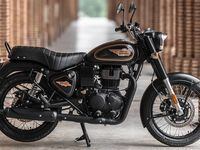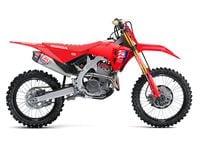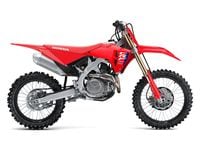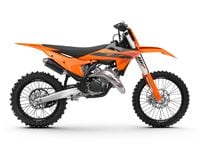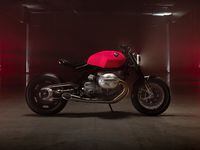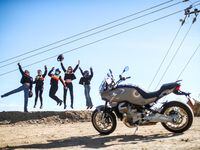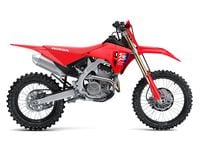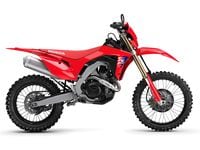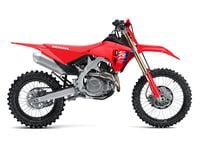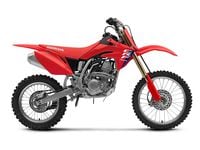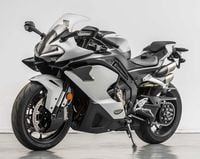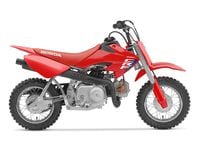Motorcyclists come in all shapes and sizes. And a major selling point for many riders is seat height. Kawasaki mentioned in its presentation for the KLX230 S that small riders have grown accustomed to adapting to large and oversized motorcycles or spending money lowering their bikes through a third party. Understanding a demand for shorter off-road bikes, Kawasaki debuted the “S” trim for the KLX230 as well as the KLR650.
Rolling out the S model in a variety of Kawasaki models means more riders can be comfortable when swinging a leg over a green machine. This may lead to new or small riders, riding more often, more comfortably, and more confidently with less of a risk of feeling in over their heads, according to Kawasaki.
The Japanese manufacturer released the KLX230 a few years ago and since then has added several trim options for consumers. For model year 2023, the KLX230 is available in the standard model ($4,999), S model ($4,999), S model with ABS ($5,299), and the KLX230SM ($5,299) and SM equipped with ABS ($5,599).
Utilizing the diverse platform of the KLX, Kawasaki offers the 230 in a variation that can suit a large variety of new and beginning riders. New for 2023 is the KLX230 S which offers the same package as the standard model but now with a 2-inch-lower seat height according to Kawasaki. A few updates the ‘23 models received include a new LED headlight, new front fender, ECU changes for better compensation at altitude, improved throttle response, a lower idle, and improved response off-idle.
The lowered seat height of the S model is achieved through shortening the suspension travel from 8.6 inches to 6.2 inches in the front and from 8.8 inches to 6.6 inches in the rear. Acknowledging the challenges of less suspension travel Kawasaki designated specific suspension valving to the S model. The rear is fitted with a 48–76 Nm progressive spring rate and the fork has stiffer compression and less rebound.
Having spent a lot of time on the 2022 Kawasaki KLX230, I felt at home when mounting the bike. Two differences are instantly noticeable: The ground was certainly closer, and the suspension was noticeably stiffer. The first hour aboard the 2023 Kawasaki KLX230 S was a mixture of smooth pavement, city roads, and broken asphalt backroads. Throughout grid-structured towns the KLX230 works great. Its light and nimble chassis matched with a linear powerband is a great package for dicing up suburbia.
Once the pavement becomes linear and the speeds are north of 70, the KLX does become inferior to the passing automobiles. Not to say the 230 isn’t capable of highway speeds, but it certainly prefers tight and twisty. Traversing rough backroads littered with dirty corners and broken asphalt, the KLX230 S can go full supermoto. With rear ABS disabled via a button on the handlebar, stepping out the rear on corner entry became easily achievable. Getting back up to speed on corner exit requires a handful of throttle and a quick kick at the shifter. Repeating this time and again from one corner to the next never got old.
In the dirt, the 2023 Kawasaki KLX230 S provides endless confidence. The low center of gravity and lack of radiators contributes to razor-sharp handling and a slim profile. While the linear powerband delivers smooth get-up-and-go without any unwanted drama. Spinning the rear tire off-road requires ambition to do so. When wanting to steer with the rear and perform a powerslide, the KLX230 demands a big windup of the engine before dropping the clutch. Even on loose fire roads, the stock IRC Trails GP tires provided Velcro-like traction. For riders developing their off-road skills, the combination of light handling, endless traction, and low center of gravity will further improve confidence when challenging oneself in the dirt.
When riding mostly on fire roads and open, flowing trails, the gear ratio is just right. Using second, third, and fourth gear off-road, each shift was hunky dory. On tighter corners, second gear is preferred if wanting to maximize forward drive, but third gear easily can chug through sections even at low speeds. Through faster, flowing parts, fourth gear is preferred. Lugging the bike through rock gardens and rough sections, third and fourth gear allows the 230 chassis to float through the chunk while still providing enough engine grunt to propel the bike forward.
Off-road, the revised suspension on the S held up to any abuse the trail dished out. Its 37mm telescopic fork provides holdup in the initial part of the stroke with a plush sensation in the mid-stroke and plenty of bottoming resistance. Providing only 6.2 inches of travel, every inch gets used off-road, but not once did I bottom out the front or rear.
The Uni-Trak shock and linkage offers preload adjustments, but no changes were needed. Specific to the S model, the 48–76 Nm progressive spring rate equaled the fork’s performance. Tackling obstacles and railing corners, the rear of the bike continually felt planted. Providing enough holdup to stay in the initial part of the stroke, the bike doesn’t sag in the rear leading to a stink bug stance. The damping in the rear felt just right for my weight and speed. Blipping off rocks and square edges, the KLX230 S does not have a tendency to go full huck a buck on rebound. Commonly on entry-level off-road machines, the rear is too soft leading to the bike blowing through the stroke before rebounding on itself. No pogoing from this green machine.
New for 2023, Kawasaki has added switchable ABS to the KLX lineup. Easily turn ABS off (rear only) via a push-button on the left side of the handle bar. To successfully do so, the bike must be in neutral at a dead stop. Although only the rear can be deactivated, switchable ABS is a premium feature for an entry-level dual sport. Additionally, the ABS won’t automatically switch back on when flicking the kill switch. Only if the key is turned off, killing all power, does the ABS come back on.
According to Kawasaki, the ABS algorithm is tuned for off-road use, which means the system is less intrusive than a road application for an optimal off-road experience. Thinking of myself as hard on the brakes, I only noticed the system kick on once. Spending most of the ride with ABS disabled, I was able to perform necessary skids when the terrain called for it. And for those who want nothing to do with electronic aids, a non-ABS model is available for $4,999 in Lime Green only.
Kawasaki offers a small-displacement, entry-level dual sport motorcycle in two different height variations with optional ABS ($300 upcharge) and modern features such as fuel injection, LED headlight, throttle-by-wire, and disc brakes front and rear. Currently, there are not many manufacturers offering comparable motorcycles with a suggested retail of $5K. Even electric bicycles can cost more than the suggested retail of a brand-new KLX230 S.
A notable option, the Yamaha XT250 ($5,299) does retail for the same price, but the KLX230 S features LED lighting and a switchable (rear only) ABS system, two things the Yamaha does not. Any new or beginning rider in the market for an entry-level dual-purpose machine absolutely should consider the KLX230 or KLX230 S depending on their vertical needs.
Helmet: Arai XD-4
Jacket: Alpinestars Session Race
Pants: Alpinestars Venture-R
Gloves: Alpinestars Full Bore
Boots: Alpinestars Tech 7 Enduro
/cloudfront-us-east-1.images.arcpublishing.com/octane/Y2PJ7KNVW5DH5BW557U2CXUDTI.jpg)
/cloudfront-us-east-1.images.arcpublishing.com/octane/MYFPWMWLSBETBBD5ICEUHSQOFY.jpg)
/cloudfront-us-east-1.images.arcpublishing.com/octane/LU4II3YSIBAJHM2CSOGDAPVANM.jpg)
/cloudfront-us-east-1.images.arcpublishing.com/octane/CIHHIUQ6WREHBKS5OCWFQYTF7U.jpg)
/cloudfront-us-east-1.images.arcpublishing.com/octane/GN5IKKZUBJCTLFJZYGICVJLKG4.jpg)
/cloudfront-us-east-1.images.arcpublishing.com/octane/YRCFNUFUCZFFZN5PHT6BMQPJR4.jpg)
/cloudfront-us-east-1.images.arcpublishing.com/octane/PNVW5I3UVJAHJLL2WVNDFX6SLI.jpg)
/cloudfront-us-east-1.images.arcpublishing.com/octane/FOT6Z2QOTVEFVGIV74QMOWSICE.jpg)
/cloudfront-us-east-1.images.arcpublishing.com/octane/6ALJX4CM65CD5NRHYVGSFXHGSQ.jpg)
/cloudfront-us-east-1.images.arcpublishing.com/octane/4SUMOJU33JAWPI7QEOAILXPYAY.jpg)
/cloudfront-us-east-1.images.arcpublishing.com/octane/BXI6AULEBZBTNBI2V3V7Z3W2P4.jpg)
/cloudfront-us-east-1.images.arcpublishing.com/octane/NMXICVHO4FHYDKAFVVUVJVABT4.jpg)
/cloudfront-us-east-1.images.arcpublishing.com/octane/QQ5JJPZFWRDCTCI3FEV3TY37MI.jpg)
/cloudfront-us-east-1.images.arcpublishing.com/octane/B4SY6IT6FZA5TIBQQMLLQ2BY4E.jpg)
/cloudfront-us-east-1.images.arcpublishing.com/octane/HL2CMJKJX5B5PNNEFNNDTDKMME.jpg)
/cloudfront-us-east-1.images.arcpublishing.com/octane/WAPSFRSEWFCIVPDOWMS2FZMP6M.jpg)
/cloudfront-us-east-1.images.arcpublishing.com/octane/NYWQEXJRJNC6RJ4AOFQ672B5LE.jpg)
/cloudfront-us-east-1.images.arcpublishing.com/octane/LO6EW3UIDRCDDKBKQFNU43E4F4.jpg)
/cloudfront-us-east-1.images.arcpublishing.com/octane/HWPE5V6WMNF2XIQ24TBIQRRNWA.jpg)
/cloudfront-us-east-1.images.arcpublishing.com/octane/FQVR53U5ARE5VCHT36Q23DDEPY.jpg)
/cloudfront-us-east-1.images.arcpublishing.com/octane/MXDLKJJD2ZHCVEG65U2PQ6OZIE.jpg)
/cloudfront-us-east-1.images.arcpublishing.com/octane/KAG2NWNDPVCDPJG7BIB3PFQFXQ.jpg)
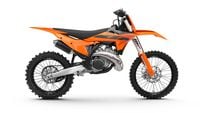
/cloudfront-us-east-1.images.arcpublishing.com/octane/N575KB7BDZDPPJBRLZRG2ANHKI.jpg)
/cloudfront-us-east-1.images.arcpublishing.com/octane/T77HXRXV4NGKDNZODMSEIBRXPE.jpg)
/cloudfront-us-east-1.images.arcpublishing.com/octane/NKMM7V2P3BCSXAV6J56FKK67OU.jpg)
/cloudfront-us-east-1.images.arcpublishing.com/octane/SWQRQV27DNFA7LXGFI7FNFNGOQ.jpg)
/cloudfront-us-east-1.images.arcpublishing.com/octane/GYEXUJBV5JGQLLZNXO7KRVSTEY.jpg)
/cloudfront-us-east-1.images.arcpublishing.com/octane/MCWUSJJVJVG45P7QQG3WOXZR54.jpg)
/cloudfront-us-east-1.images.arcpublishing.com/octane/AJ4EFPH2CRDURDAB5LPEA2V2NE.jpg)
/cloudfront-us-east-1.images.arcpublishing.com/octane/LSDHIL22SZAFFPYLKP5ZXLJSIY.jpg)
/cloudfront-us-east-1.images.arcpublishing.com/octane/SH46HIOX4RELXLXF6AE3SFGH4A.jpg)
/cloudfront-us-east-1.images.arcpublishing.com/octane/JUZ52WFWLJGMNH7PGZNOKP3MUY.jpg)
